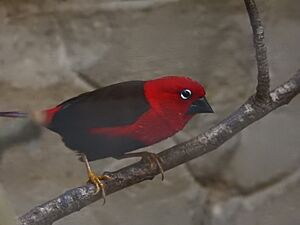Crimson seedcracker facts for kids
Quick facts for kids Crimson seedcracker |
|
|---|---|
 |
|
| male at ZooParc de Beauval | |
| Conservation status | |
| Scientific classification | |
| Genus: |
Pyrenestes
|
| Species: |
sanguineus
|
The crimson seedcracker (Pyrenestes sanguineus) is a small, colorful bird. It belongs to a group of birds called estrildid finches. You can find these birds in many parts of Africa. They live in countries like Burkina Faso, Côte d'Ivoire, Gambia, Guinea, Guinea-Bissau, Liberia, Mali, Senegal, and Sierra Leone. Scientists believe there are many of these birds, so they are not currently in danger.
Contents
What Does a Crimson Seedcracker Look Like?
This bird is about 14 cm (5.5 in) long. That's about the size of a small sparrow. It has a round body and a rounded head. Its beak is wide and very pointed.
The top part of its body is dark brown or brownish-black. Its head, neck, face, chin, throat, chest, and sides are a bright, shiny crimson-red. The outer feathers on its tail are brown. However, the rump (the area above the tail) and the two middle tail feathers are also crimson.
The underside of the bird is dark brown. Its beak is a cool steel-blue color. It has brown eyes with white eyelids. Its legs are brown or olive-brown. Both male and female birds look very similar. The only small difference is that the female's upper parts are a slightly lighter brown.
Where Do Crimson Seedcrackers Live?
The crimson seedcracker lives in tropical West Africa. Its home range stretches from Senegal and Gambia all the way to southern Mali and Ivory Coast.
These birds like to live in places with lots of thick plants. You can find them in swamps with fresh water or in marshy areas. They also live near tidal creeks and rice fields. They enjoy bushy areas close to rivers and streams.
How Do Crimson Seedcrackers Behave?
The crimson seedcracker has a very strong, wide beak. This special beak helps it eat seeds from grasses, sedges, and rice. It's especially good at cracking open seeds that are very hard.
These birds usually look for food hidden in thick plants. Sometimes, you might see them feeding on the ground in open areas. They often stay close to bushes. They might feed alone, in pairs, or with other small birds like bluebills.
When a crimson seedcracker flies, it takes off with a few twists. Then, it flies in a wavy pattern, much like a sparrow. These birds usually breed in September.
Different Beak Sizes
Crimson seedcrackers are interesting because they can have different beak sizes. Some have large beaks, and others have small beaks. This difference is not about if they are male or female. It's also not about their body size, age, or where they come from.
Instead, the beak size is linked to what they eat. Birds with larger beaks can crack open bigger and harder seeds. For example, they can eat the tough seeds from plants called nutrushes. Scientists think that a small change in one of their genes might cause these big differences in their beak shapes.
Is the Crimson Seedcracker in Danger?
The crimson seedcracker does not migrate, meaning it stays in the same area all year. It lives across a large part of West Africa. This bird is quite shy and can be hard to spot. Because of this, people might think there are fewer of them than there actually are.
However, scientists believe the number of crimson seedcrackers is steady. The International Union for Conservation of Nature has looked at its situation. They have decided that the bird is a "least concern" species. This means it is not currently at risk of disappearing.


